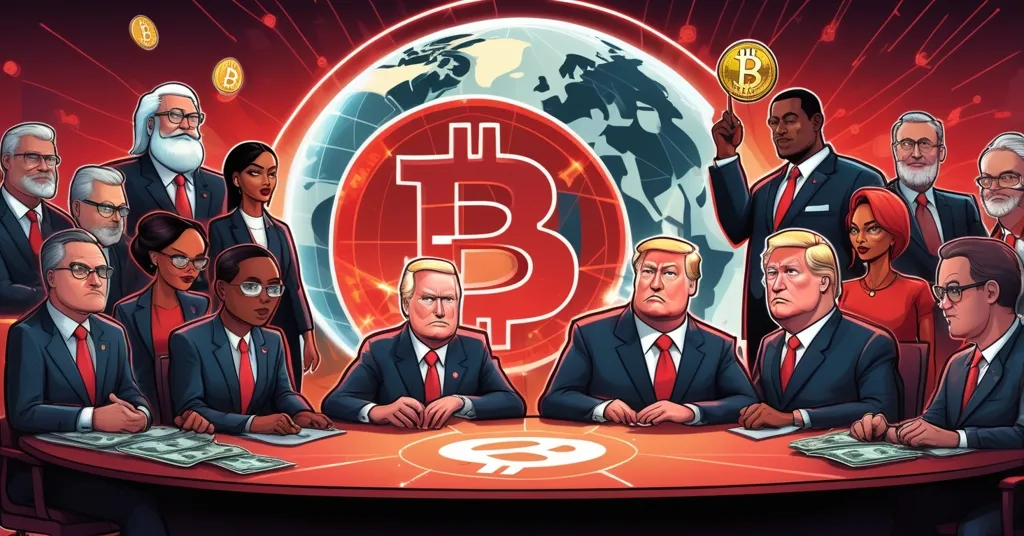Brazil’s Lula Slams U.S. Tariffs at BRICS Summit: Bitcoin’s Role in Economic Freedom

Brazil’s Lula Slams U.S. Tariff Threats at BRICS Summit: Bitcoin’s Potential in Economic Freedom
Brazilian President Luiz Inácio Lula da Silva delivered a scathing rebuke of U.S. tariff threats during the recent BRICS Summit in Kazan, Russia, signaling a growing defiance among emerging economies against American economic dominance. With global trade tensions boiling over, Lula’s push to reduce reliance on the U.S. dollar and the bloc’s unified stand against coercive tariffs open a fascinating door for decentralized solutions like Bitcoin and blockchain to reshape international finance.
- U.S. Showdown: Lula rejects Trump’s tariff threats as outdated economic imperialism.
- Dollar Pushback: BRICS leaders advocate for trade systems free from U.S. dollar control.
- Crypto Angle: Bitcoin and blockchain could offer BRICS a path to financial autonomy.
BRICS Summit: A Defiant Stand Against Tariffs
The BRICS Summit, held from October 22-24, 2024, in Kazan, Russia, convened leaders from Brazil, Russia, India, China, and South Africa, along with newer full members Egypt, Ethiopia, Iran, and the United Arab Emirates. Saudi Arabia participated as a partner despite accepting full membership, while over 30 nations have signaled interest in joining this coalition of emerging economies. Formed in 2009 (initially as BRIC, with South Africa added in 2010), BRICS has positioned itself as a counterweight to Western-led groups like the G7 and G20, championing a multipolar economic order. This year’s gathering ended with a sharp condemnation of tariff barriers and geopolitical conflicts, including a recent bombing of Iran, reinforcing the bloc’s commitment to multilateral cooperation over unilateral coercion, as detailed in the outcomes of the 2024 Kazan summit.
The flashpoint of the summit was U.S. President Donald Trump’s threat of retaliatory tariffs on BRICS nations, framed as a response to policies perceived as hostile to American interests. Reports indicate Trump floated a potential 10% levy on countries aligning with what he called “Anti-American policies of BRICS,” though U.S. sources clarified to Reuters that no immediate tariff is set unless provocations escalate. This echoes earlier warnings from February, when Trump threatened “full-scale duties” if BRICS moved to erode the U.S. dollar’s global dominance, a stance further explored in Trump’s statements on trade. It’s a textbook “America First” move—wielding economic leverage to keep nations in check. But Lula, leading the charge, fired back with unapologetic clarity.
“The world has changed. We don’t want an emperor.”
His words cut through the diplomatic haze, rejecting U.S. attempts to dictate trade terms. Lula stressed that BRICS isn’t about confrontation but reimagining global economics, declaring:
“This is a set of countries that wants to find another way of organizing the world from the economic perspective.”
Responses from other BRICS leaders varied in tone but aligned in intent. South Africa’s President Cyril Ramaphosa played the diplomat, stating:
“The bloc does not want to single out one power,”
while signaling openness to trade talks with the U.S. China’s Foreign Ministry spokesperson Mao Ning didn’t hold back, asserting:
“Tariffs should not be used as a tool for coercion and pressuring.”
Russia’s Kremlin echoed that their BRICS cooperation isn’t aimed at any third party, while India stayed conspicuously silent on the tariff issue. Newer partners like Malaysia, having recently scrapped a 24% tariff barrier, doubled down on independent economic policies. Indonesia’s economic affairs minister, Airlangga Hartarto, even traveled to Washington to negotiate directly on the tariff threats, highlighting the diverse strategies within the bloc, a topic discussed widely on platforms like online forums about U.S. tariff policies.
De-Dollarization: Stripping Away U.S. Financial Control
Beyond the tariff clash, a central theme at Kazan was reducing dependency on the U.S. dollar for international trade settlements. For the uninitiated, de-dollarization means shifting away from using the dollar as the default currency for global transactions, a system that gives the U.S. immense power through control over financial mechanisms like SWIFT—a global messaging network banks use for cross-border payments, often in dollars. Roughly 88% of international transactions still flow through dollar-based systems, per SWIFT data, making nations vulnerable to U.S. sanctions or policy shifts. Lula was blunt about the need for change, a perspective further analyzed in expert commentary on de-dollarization efforts:
“The world needs to find a way that our trade relations don’t have to pass through the dollar.”
This isn’t mere posturing. During Brazil’s past BRICS presidency, talks of a shared currency were sidelined under U.S. pressure, but the hunger for financial autonomy persists. Leaders discussed coordinating central banks for incremental shifts, while Russia’s track record of exploring alternatives under Western sanctions—like crypto for oil payments—points to unconventional paths forward. The reality, however, is a messy web of challenges. Many BRICS economies can’t afford a full break from the dollar, and internal rifts, from India-China border disputes in the Himalayas to Iran-UAE regional tensions, threaten cohesive action. The intent is bold, but the execution remains a gamble, especially with BRICS expansion impacting global trade dynamics.
Bitcoin and Blockchain: Tools for BRICS Sovereignty?
Enter Bitcoin and blockchain technology—potential wildcards in BRICS’ quest for trade independence. For newcomers, Bitcoin is a decentralized digital currency running on a peer-to-peer network, free from any central authority like a government or bank. Blockchain, the tech behind it, acts as a secure, distributed ledger recording transactions across countless computers, untouchable by any single nation. Together, they offer a way to sidestep dollar-centric systems like SWIFT, which can be weaponized via sanctions. Imagine Russia settling a trade deal with Brazil in Bitcoin, bypassing U.S.-controlled intermediaries entirely. It’s a direct line to financial freedom, or at least a compelling pitch, as discussed in community insights on Bitcoin’s role in economic freedom.
As Bitcoin maximalists would argue—and I lean this way—BTC stands as the ultimate decentralized money, a digital gold with unmatched security and a global network effect. It could serve as BRICS’ unconfiscatable reserve asset, a hedge against currency manipulation or sanctions. Look at El Salvador, which adopted Bitcoin as legal tender in 2021 to assert economic sovereignty, despite rocky implementation. BRICS nations could similarly position Bitcoin as a settlement layer for large-scale trade, a store of value no emperor can seize. But let’s not pretend BTC covers every base. Its price can swing 10% in a day—hardly ideal for invoicing soybeans or steel. This is where altcoins and other blockchains like Ethereum shine, filling niches Bitcoin shouldn’t, a concept explored in academic research on Bitcoin and de-dollarization.
Ethereum, for instance, supports smart contracts—self-executing agreements coded on the blockchain—that could automate complex BRICS trade deals with minimal trust needed. Stablecoins, often pegged to local currencies or commodities and built on platforms like Ethereum, could dodge Bitcoin’s volatility, offering a steadier medium for transactions. Russia’s digital ruble pilot and China’s Blockchain Service Network (BSN) show BRICS nations already experimenting with decentralized tech, while Brazil’s crypto adoption—over 8% of its population owned digital assets by 2023, per Statista—signals growing comfort with the space. A diverse crypto ecosystem isn’t a bug; it’s a feature, even if it’s plagued by scams we’ll call out every damn time.
Roadblocks: Can Crypto and BRICS Really Align?
Before we get carried away with visions of a Bitcoin-powered BRICS utopia, let’s slam the brakes. Crypto adoption at this scale faces brutal hurdles. Volatility is the obvious beast—BTC’s price swings could give even hardened finance ministers whiplash, making it a risky bet for trade settlements. Regulatory misalignment is just as ugly. China bans crypto trading outright, India slaps heavy taxes but allows it, and Brazil’s relatively friendly stance isn’t universal. A unified BRICS crypto strategy? Good luck with that patchwork, as highlighted by Lula’s strong rejection of U.S. tariff threats.
Then there’s the geopolitical baggage. Aligning decentralized tech with controversial regimes—think Iran or potential future members like Cuba—risks tainting crypto’s image in Western eyes, slowing global acceptance. Blockchain projects themselves aren’t immune to failure; poorly designed systems collapse, and scams bleed users dry. We’re all for effective accelerationism, pushing tech to disrupt the status quo, but blind hype is a poison. Adoption must be grounded, not a fever dream peddled by shysters promising 100x returns. And let’s not forget BRICS’ internal drama—how do you build a shared financial system when China and India can’t agree on a border, or when Iran and the UAE glare across the Gulf? These rivalries could tank any grand plan, crypto or otherwise, faster than a bear market, a dynamic rooted in the broader context of BRICS history and goals.
Chaos and Opportunity: What’s Next for BRICS and Crypto?
Stepping back, the Kazan summit and Lula’s fiery stand aren’t just about tariffs or trade stats—they’re a middle finger to a world order where one currency, and one nation, holds all the leverage. BRICS is betting on a future with multiple power centers, where economic rules aren’t dictated by a single “emperor.” Whether Bitcoin or blockchain become serious players in this shift hinges on navigating tech pitfalls as much as geopolitical landmines. Picture a BRICS trade system in a decade: a stablecoin backed by oil or gold for day-to-day deals, with Bitcoin as the unassailable reserve underneath. Far-fetched? Maybe. But the old guard is being challenged, and the chaos—oh, we’re here for every disruptive second of it.
Key Takeaways and Questions
- What’s behind the U.S. tariff threats to BRICS nations?
The U.S. aims to protect its economic dominance, using tariffs as a deterrent against BRICS policies that could undermine the dollar or challenge American trade interests. - Why does Lula push so hard against U.S. dollar reliance?
Lula seeks financial autonomy for BRICS, arguing that dollar dependency leaves nations exposed to U.S. policy swings and sanctions, necessitating alternative trade mechanisms. - How does BRICS counter U.S. economic pressure?
BRICS promotes multilateral cooperation, denouncing tariffs as coercive and pursuing independent trade systems to rival Western-dominated financial structures. - Can Bitcoin and blockchain aid BRICS in gaining economic freedom?
Absolutely, they provide decentralized alternatives to bypass dollar-centric systems and resist sanctions, though volatility and regulatory hurdles remain significant obstacles. - What risks does BRICS face by embracing crypto for trade?
Risks include Bitcoin’s price instability, fragmented regulations across member states, and potential backlash from aligning with controversial regimes, which could stall broader crypto adoption.



